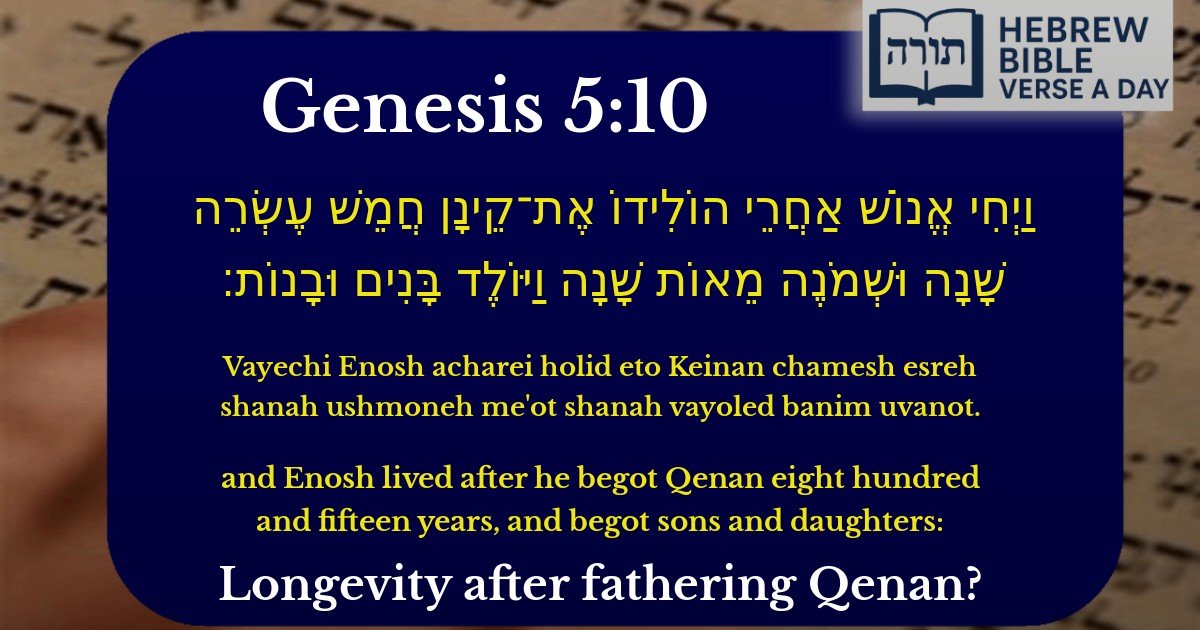Join Our Newsletter To Be Informed When New Videos Are Posted
Join the thousands of fellow Studends who rely on our videos to learn how to read the bible in Hebrew for free!
Hebrew Text
וַיְחִי אֱנוֹשׁ אַחֲרֵי הוֹלִידוֹ אֶת־קֵינָן חֲמֵשׁ עֶשְׂרֵה שָׁנָה וּשְׁמֹנֶה מֵאוֹת שָׁנָה וַיּוֹלֶד בָּנִים וּבָנוֹת׃
English Translation
and Enosh lived after he begot Qenan eight hundred and fifteen years, and begot sons and daughters:
Transliteration
Vayechi Enosh acharei holid eto Keinan chamesh esreh shanah ushmoneh me'ot shanah vayoled banim uvanot.
Hebrew Leining Text
וַיְחִ֣י אֱנ֗וֹשׁ אַֽחֲרֵי֙ הוֹלִיד֣וֹ אֶת־קֵינָ֔ן חֲמֵ֤שׁ עֶשְׂרֵה֙ שָׁנָ֔ה וּשְׁמֹנֶ֥ה מֵא֖וֹת שָׁנָ֑ה וַיּ֥וֹלֶד בָּנִ֖ים וּבָנֽוֹת׃
וַיְחִ֣י אֱנ֗וֹשׁ אַֽחֲרֵי֙ הוֹלִיד֣וֹ אֶת־קֵינָ֔ן חֲמֵ֤שׁ עֶשְׂרֵה֙ שָׁנָ֔ה וּשְׁמֹנֶ֥ה מֵא֖וֹת שָׁנָ֑ה וַיּ֥וֹלֶד בָּנִ֖ים וּבָנֽוֹת׃
🎵 Listen to leining
Parasha Commentary
📚 Talmud Citations
This verse is not quoted in the Talmud.


Understanding the Verse in Context
The verse (Bereishit 5:10) is part of the genealogical list in Sefer Bereishit detailing the generations from Adam to Noach. Enosh was the son of Shet (Seth) and the grandson of Adam. The Torah emphasizes that Enosh lived for 815 years after fathering Qenan (Kenan) and had additional children during that time.
Rashi's Commentary
Rashi (Bereishit 5:9) notes that the Torah consistently records the ages of these early generations in a similar pattern: the years lived after fathering a son, followed by additional years of life and further childbearing. This structure underscores the importance of continuity and the fulfillment of the divine command to "be fruitful and multiply" (Bereishit 1:28).
The Significance of Longevity
The unusually long lifespans of these early generations are discussed in the Talmud (Sanhedrin 69b), where the Sages explain that before the Flood, human physiology and the natural order were different, allowing for extended life. Rambam (Moreh Nevuchim 2:47) suggests that these extended years symbolize spiritual and intellectual development, as these generations were closer to the original perfection of Creation.
Enosh and the Introduction of Idolatry
Midrash (Bereishit Rabbah 23:7) connects Enosh's generation to the beginning of idolatry, stating that in his time, people started to worship false deities. Despite this, Enosh himself is not singled out as a sinner, and his long life suggests he maintained some level of righteousness. The Maharal (Gur Aryeh on Bereishit 4:26) explains that Enosh's name (related to enoshut, "human frailty") hints at the spiritual decline that began in his era.
Lessons for Future Generations